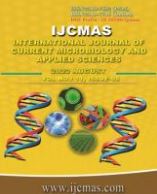


 National Academy of Agricultural Sciences (NAAS)
National Academy of Agricultural Sciences (NAAS)

|
PRINT ISSN : 2319-7692
Online ISSN : 2319-7706 Issues : 12 per year Publisher : Excellent Publishers Email : editorijcmas@gmail.com / submit@ijcmas.com Editor-in-chief: Dr.M.Prakash Index Copernicus ICV 2018: 95.39 NAAS RATING 2020: 5.38 |
Introduction: Leprosy remains one of the major public health hazards in the world even today. It is caused by Mycobacterium leprae, which is an acid-fast and rod-shaped bacillus. It is mainly transmitted by close and intimate contact with untreated cases via droplets from nasal and oral secretions and rarely through the skin. It is endemic in tropical countries, especially in developing countries in South-East Asia, America, Africa, Eastern Pacific and Western Mediterranean. Early case detection and prompt treatment have been identified as key strategies for effective control and elimination of leprosy disease. This article aims to study the role of Slit Skin Smear in the diagnosis of doubtful cases of Hansen’s disease. Materials and Methods: After enrolment of doubtful cases of the leprosy patients, a detailed history and demographic information were collected with their consent in addition to obtaining slit skin smear (SSS) as per the standard protocol. The SSS were stained with modified Ziehl- Neelson stain (5% sulphuric acid) and viewed under an oil immersion microscope. Results and Discussion: From a total of 120 clinically doubtful cases of leprosy, 23 (19.1%) were SSS positive. These cases were neither previously diagnosed as leprosy nor had undergone any treatment for leprosy. Among the 23 SSS positives, there was a male predominance (78.2%); 78.3% were from rural area and 65.2% were from economically low background. The most predominant age group among SSS positives were 30-40 years (43.4%) followed by 40-50 years (34.7%). In the 23 positive cases, BI 1+ was present in 70% and borderline tuberculoid in 66.7%. Among 120 doubtful cases, paucibacillary (PB) accounted for 80.9% being the highest number against 19.1% of cases with multibacillary (MB) disease. Further treatment and follow up action on the cases of SSS positive as per the result of the study were intimated to Dermatology department. Conclusion: Hansen’s disease is still a threat and challenge to human life. Early detection, treatment, awareness building and community education will reduce the prevalence consequently leading to eradicate the disease altogether.
 |
 |
 |
 |
 |